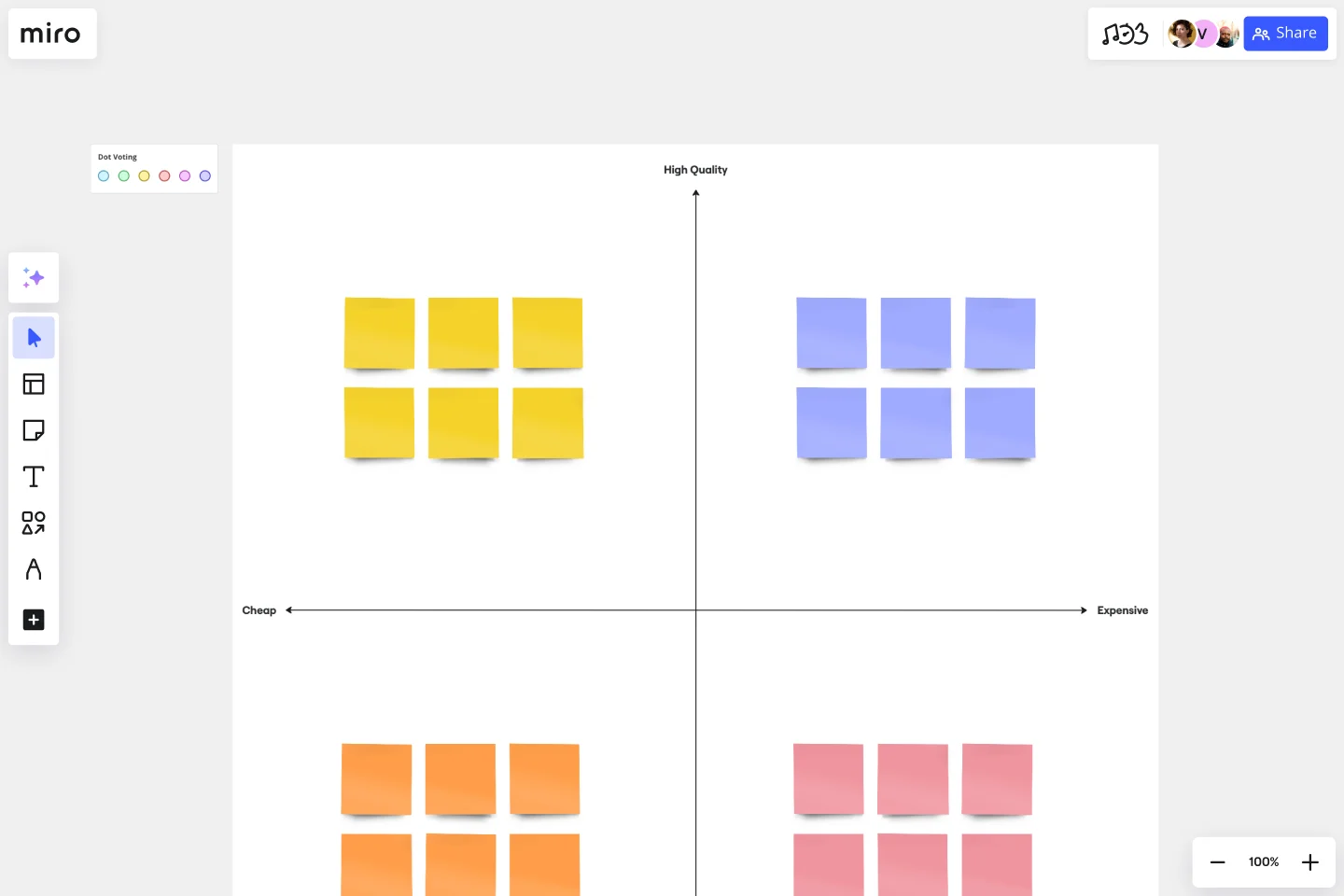Perceptual Map Template
Visually represent customers’ perceptions of your company, brand, product, or service.
About the perceptual map template
What is a perceptual map?
A perceptual map is a visual representation of customers’ or potential customers’ perceptions. Perceptual maps are used to assess organizations, brands, products, ideas, goods, or services.
Perceptual mapping is a powerful diagrammatic technique. To create a perceptual map, you must first draw two or more axes. The axes display your company’s product, brand, or service relative to your competition. Many marketers and product managers choose to use different size circles to represent sales volume or market share of competing products, though this is optional. You can then ask participants to rank competing products relative to each other along these axes. The resulting map gives you insight into how customers feel about competing products in a given market.
What can you use a perceptual map to assess?
You can use a perceptual map to assess a wide range of attributes such as price, performance, safety, and reliability. There are a variety of benefits to using a perceptual map.
Benefit 1 - Gain a better understanding of your product is positioned in a given market. If you’re operating in a dynamic, crowded market, it can be hard to know how your product measures up to the competition. If you’re operating in a small, new market, it can be equally difficult. Perceptual maps are vital for gaining insight into your relative strengths and weaknesses.
Benefit 2 - Discover how customers and potential customers perceive your brand. Many businesses ship goods or services without any view into why their customers bought them -- or why potential customers failed to do so. Perceptual mapping puts you in touch with your customers’ decision-making processes.
Benefit 3 - Assess your competition’s strengths and weaknesses. Since perceptual maps situate your business relative to your competition, it can help you figure out what your competitors are doing right and wrong.
Benefit 4 - Help your business understand gaps in the market. When your business is successful, it can be easy to keep shipping the same (or similar) products year after year without iterating. Perceptual maps help you explore the market and probe for unseen gaps, which might be ripe for exploitation.
Benefit 5 - Understand changes in customer behavior and purchasing decisions. Maybe your customers suddenly stopped buying a certain product, or maybe they started buying that product en masse. Either way, it’s crucial to understand why so you can make decisions going forward. A perceptual map gets at the heart of customer behavior.
Why use a perceptual map?
You can use a perceptual map to understand what your customers think about you and your competitors. This can help you track market trends, identify gaps in the market, and develop your branding and marketing strategies.
Get started with this template right now.
Jobs to be Done template
Works best for:
Ideation, Design Thinking, Brainstorming
It’s all about a job done right — customers “hire” a product or service to do a “job,” and if it's not done right, the customer will find someone to do it better. Built on that simple premise, the Jobs To Be Done (JTBD) framework helps entrepreneurs, start-ups, and business managers define who their customer is and see unmet needs in the market. A standard job story lets you see things from your customers’ perspective by telling their story with a “When I…I Want To…So That I …” story structure.
Experience Mapping Template
Works best for:
Desk Research, Mapping
Plan your product according to your customer’s needs and desires with the Experience Map Template. Bring a customer-centric approach to product development and branding.
Purple Sector Empathy Map
Works best for:
Market Research, Research & Design
Purple Sector Empathy Map is an innovative tool for exploring user experiences. By visualizing users' thoughts, feelings, and behaviors, you can create more engaging and user-friendly products. Ideal for teams focused on user experience.
Service Definition Canvas
Works best for:
Research & Design
The Service Definition Canvas helps you define and visualize the core components of your service. This template is perfect for outlining service interactions, identifying improvement areas, and aligning teams. Use it to create a clear and comprehensive service blueprint that enhances customer experience and operational efficiency. It's ideal for strategic planning and ensuring a cohesive understanding of service delivery among stakeholders.
2x2 Prioritization Matrix Template
Works best for:
Operations, Strategic Planning, Prioritization
Ready to set boundaries, prioritize your to-dos, and determine just what features, fixes, and upgrades to tackle next? The 2x2 prioritization matrix is a great place to start. Based on the lean prioritization approach, this template empowers teams with a quick, efficient way to know what's realistic to accomplish and what’s crucial to separate for success (versus what’s simply nice to have). And guess what—making your own 2x2 prioritization matrix is easy.
3x3 Prioritization Method Template
Works best for:
Operations, Prioritization, Strategic Planning
It’s all about assessing a task or idea, and quickly deciding the effort it will take and the potential impact it will have—ranked low, medium, or high. That’s what the 3x3 prioritization method does: Help teams prioritize and identify quick wins, big projects, filler tasks, or time-wasters. With nine bucket areas, it offers slightly greater detail than the 2x2 Prioritization Matrix (or Lean Prioritization Method). It’s easy to make your own 3x3 prioritization matrix—then use it to determine what activities or ideas to focus on with your valuable resources.
